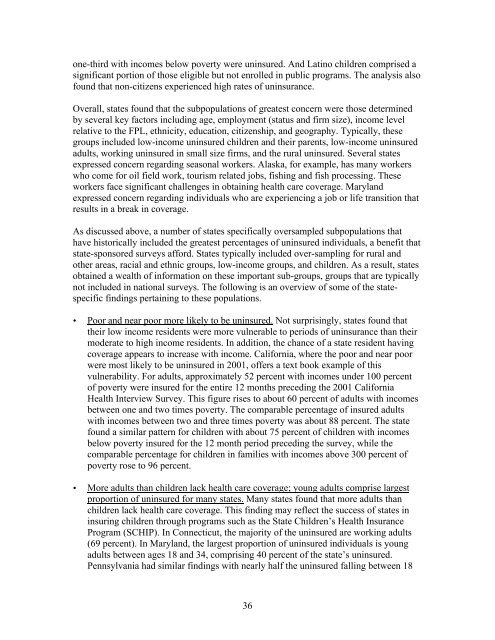SPG synthesis report - State Coverage Initiatives
SPG synthesis report - State Coverage Initiatives
SPG synthesis report - State Coverage Initiatives
You also want an ePaper? Increase the reach of your titles
YUMPU automatically turns print PDFs into web optimized ePapers that Google loves.
one-third with incomes below poverty were uninsured. And Latino children comprised a<br />
significant portion of those eligible but not enrolled in public programs. The analysis also<br />
found that non-citizens experienced high rates of uninsurance.<br />
Overall, states found that the subpopulations of greatest concern were those determined<br />
by several key factors including age, employment (status and firm size), income level<br />
relative to the FPL, ethnicity, education, citizenship, and geography. Typically, these<br />
groups included low-income uninsured children and their parents, low-income uninsured<br />
adults, working uninsured in small size firms, and the rural uninsured. Several states<br />
expressed concern regarding seasonal workers. Alaska, for example, has many workers<br />
who come for oil field work, tourism related jobs, fishing and fish processing. These<br />
workers face significant challenges in obtaining health care coverage. Maryland<br />
expressed concern regarding individuals who are experiencing a job or life transition that<br />
results in a break in coverage.<br />
As discussed above, a number of states specifically oversampled subpopulations that<br />
have historically included the greatest percentages of uninsured individuals, a benefit that<br />
state-sponsored surveys afford. <strong>State</strong>s typically included over-sampling for rural and<br />
other areas, racial and ethnic groups, low-income groups, and children. As a result, states<br />
obtained a wealth of information on these important sub-groups, groups that are typically<br />
not included in national surveys. The following is an overview of some of the statespecific<br />
findings pertaining to these populations.<br />
• Poor and near poor more likely to be uninsured. Not surprisingly, states found that<br />
their low income residents were more vulnerable to periods of uninsurance than their<br />
moderate to high income residents. In addition, the chance of a state resident having<br />
coverage appears to increase with income. California, where the poor and near poor<br />
were most likely to be uninsured in 2001, offers a text book example of this<br />
vulnerability. For adults, approximately 52 percent with incomes under 100 percent<br />
of poverty were insured for the entire 12 months preceding the 2001 California<br />
Health Interview Survey. This figure rises to about 60 percent of adults with incomes<br />
between one and two times poverty. The comparable percentage of insured adults<br />
with incomes between two and three times poverty was about 88 percent. The state<br />
found a similar pattern for children with about 75 percent of children with incomes<br />
below poverty insured for the 12 month period preceding the survey, while the<br />
comparable percentage for children in families with incomes above 300 percent of<br />
poverty rose to 96 percent.<br />
• More adults than children lack health care coverage; young adults comprise largest<br />
proportion of uninsured for many states. Many states found that more adults than<br />
children lack health care coverage. This finding may reflect the success of states in<br />
insuring children through programs such as the <strong>State</strong> Children’s Health Insurance<br />
Program (SCHIP). In Connecticut, the majority of the uninsured are working adults<br />
(69 percent). In Maryland, the largest proportion of uninsured individuals is young<br />
adults between ages 18 and 34, comprising 40 percent of the state’s uninsured.<br />
Pennsylvania had similar findings with nearly half the uninsured falling between 18<br />
36






